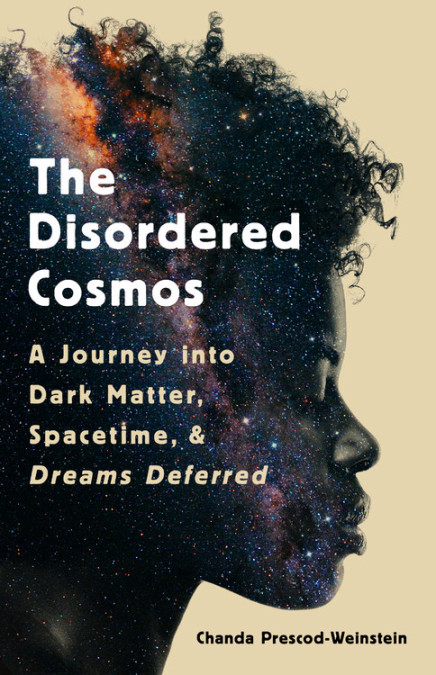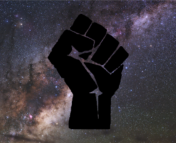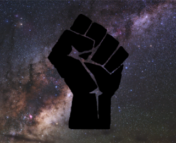CONTENT WARNING: mentions of sexual assault, violence against and murder of Black and Indigenous people, and post-traumatic stress disorder.
This post was a collaborative effort between authors Catherine Manea, Ellis Avallone, and Pratik Gandhi.
This post is part of our series #BlackInAstro. For our cornerstone post, see here. This week, we will be posting a #BlackInAstro story every day for #BlackInAstroWeek.

The Disordered Cosmos: A Journey into Dark Matter, Spacetime, & Dreams Deferred
By Dr. Chanda Prescod-Weinstein
In her debut book, The Disordered Cosmos, Dr. Chanda Prescod-Weinstein seamlessly weaves together science, her own personal experience and identity, and social activism to present a moving narrative of why physics and astronomy are inextricably tied to human identity and history. An East LA native, queer agender Black Jewish femme, and award-winning particle theorist, cosmologist, and professor at the University of New Hampshire, Prescod-Weinstein pulls from her personal experience to produce a must-read book for anyone interested in astro/physics, social justice, and the intersection between the humanities and the sciences.
Science Bereft of Humanity is No Science at All
The Disordered Cosmos is split up into four phases. Phase 1 primarily focuses on hard science, introducing the readers to the Standard Model of particle physics and the basics of cosmology, with the first chapter aptly named “I ♥ Quarks.” Prescod-Weinstein discusses particle theory and cosmology with clear, accessible language, and supplements her discussion with engaging figures that aid in the digestion of these complex topics. Her passion for particles is evident on each page, and her knack for science communication allows for a vibrant, engaging view into (arguably) one of the most complex subfields of physics. “Particle physics [. . .] continues to teach me over and over again that the universe is always more bizarre, more wonderfully queer than we think it is,” she notes. She makes intentional efforts throughout to highlight the works of Indigenous, Black, women, and non-binary physicists, mathematicians, and astronomers. She discusses the physically-inclined curvilinear geometry of the Palikur people of the Amazon, the practice of Pono science by Kānaka Maoli (Native Hawaiians) and the protectors of Maunakea, and the contributions of non-binary string theorist A.W. Peet to high-energy physics, among countless other examples.
Throughout these early chapters, she seamlessly sews together discussions of science with reflections on her own identity and those of people engaging in, directly supporting, and affected by the astrophysical endeavor. Within a discussion on special relativity, Dr. Prescod-Weinstein notes, “when we speak to the public about physics, we make it seem like a litany of lone geniuses. Rather, physics is an intensely social phenomenon. The ideas that come to populate physics… are rarely the product of one person’s ideas but rather the result of a community effort.” This structure carries on throughout the remainder of the book, where Prescod-Weinstein skillfully flows between topics typically associated with science (e.g. particle physics theory) to those typically associated with humanity (e.g. storytelling). In doing so, she presents the central theme of this work: that science and humanity are deeply intertwined and cannot, should not, be disentangled.
Blackness in Physics & Astronomy
Phase 2 shifts to focused discussions on Blackness in the sciences and astrophysics in particular. In a stand-out chapter titled “The Physics of Melanin,” Prescod-Weinstein presents a complex analysis of the molecular structure and physical characteristics of melanin, showing how a molecule used to assign inferiority and validate violence may actually be the key to greener technologies. “Part of my awakening as a Black scientist was realizing that I could use my scientific skills to understand my own Blackness,” Prescod-Weinstein reflects. In this part of the book, she directly confronts the harmful misconception that Black people are not interested in astrophysics: “There’s something deeply insidious about the inability to recognize Black people as an audience,” she reflects. She also dissects the common analogy that compares Black people to dark matter, which can be harmful and othering by implying that Black people are unusual, invisible (quite the opposite—Black people are hyper visible, she notes), and don’t interact with the universe like the rest of the population (or in this analogy, luminous matter). A better analogy, Prescod-Weinstein argues, is that between racism and weak gravitational lensing:
“Noticing the occurrence of weak gravitational lensing requires a similar capacity for pattern detection [as that required for noticing an occurrence of racism]. Weak gravitational lensing, rather than being really obvious, causes small distortions. The distortions are small enough that looking at any single galaxy might make you think, ‘Oh, that galaxy is shaped a bit oddly.’ To figure out that an image is being distorted requires looking at a whole collection of galaxies[.]”
Prescod-Weinstein also reflects on being the first Black woman to hold a PhD and professorship in theoretical cosmology: “We are rare and precious, and part of our burden is we must craft our own sense of belonging because we are in spaces where no Black woman scientist has gone before.” She concludes this phase of the book by asking “Who Is a Scientist?” In answering this question, she highlights the scientific contributions of those who have been and still are undervalued scientifically, which includes Black women, enslaved Africans who practiced engineering, math, and physics, and the women scientists whose contributions were overshadowed by their husbands. She also speaks on the universality of our curiosity about the night sky and the devaluing of Indigenous and Black thought and knowledge when it comes to the sciences.
A Multitude of Identities
In Phase 3, Prescod-Weinstein shifts to more discussions of identity in science – this time reflecting on her own experience navigating academia as a working-class Black Jewish queer femme. She reflects on her difficulties finding community, given her intersecting racial, religious, and sexual identities, and how not fitting into the dominant academic culture “sucked a lot of the fun out of physics.” She notes, “l learned to wear big hoop earrings not just because that’s how we do but because that’s how I consciously put faculty hiring committees on notice about my political commitment to Black femmes and to Black womanhood. [. . .] Speaking up is part of what makes my life in physics liveable.” In light of her experience, she calls on white astro/physicists to address structural and cultural issues in their departments that marginalize Black students. On the question of gender identities in academia, Prescod-Weinstein highlights the irony of expecting students to memorize and apply Newton’s laws in one semester but the apparent difficulty faced by those same students and professors in using the correct pronouns.
She also highlights the importance of the people who allow for science to happen: the administrative and janitorial staff that provide “scientific housework” without which science would not happen. “What would it mean to understand all of this work as part of the scientific project?” Prescod-Weinstein asks. “Recognizing and valuing the housework requires scientists to think of the humanity of the people who are not scientists but who support the scientific endeavor. It means acknowledging that it is our responsibility to support our administrative, janitorial, and food service staff when they go on strike to demand better conditions and better wages.”
She concludes the discussion of identity in science with an emotional chapter on her experience surviving rape and its inseparability from her scientific experience. “[R]ape forms a through line in my story… About 15 minutes before I wrote this paragraph, I was writing about dark matter… because to write about science and gender is to inevitably, at some point, write about rape.” She describes her experience with post-traumatic stress disorder and the ways in which her experience with rape continually encroaches onto her mental and physical science spaces. This chapter additionally highlights the pervasiveness of rape in science and academia, underscored by anecdotes of discussions with faculty at physics retreats and the frequency with which she receives emails about rape from women in science. In a powerful statement, Prescod-Weinstein again summarizes one of the primary messages of her book:
“I understand intellectually why my work on inflation and axions is interesting, but I am tired of the disjointed feelings of liking the ideas but finding it hard to breathe in the community in which I have to share them. […] Astro/physics loses so many people […] because the community refuses to acknowledge this dual reality, that science is both a mathematical process and a human, social enterprise.”
Responsibilities of the Scientific Community
Finally, in Phase 4 of the book, she focuses on astro/physics in the context of humanity and our worldly relations, the discussion of which is encapsulated by the epigraph at the beginning of the section, “Knowing that physics is a human phenomenon, we now try to understand: can we situate ourselves, collectively and humanely, in the universe?” She speaks to the undeniable colonialism that is embedded in the foundation of astronomy. Such examples include the direct violence inflicted by the astronomical community on Indigenous peoples living near telescope sites, the devaluing of contributions from Indigenous and non-European scientists, and her concerns with the United States’ approach to arriving on another planet. She follows this by arguing that science does not need to be tied to commodification and colonialism for it to work. “That doesn’t mean changing ourselves so we can be included in science — it means changing the institutionalized science, so that our presence is natural and our cultures are respected,” notes Prescod-Weinstein.
Overall, this book was a refreshing and impactful read within the popular astrophysical science genre. The Disordered Cosmos does not shy away from the problematic aspects of scientific spaces, which include racism, sexual assault, colonialism, and capitalism, or attempt to gloss over these topics with the awe that physics and astronomy often inspire. Rather, these challenging topics are carefully interwoven with discussions of the formation and evolution of our universe, particle physics, and general relativity. Furthermore, the openness with which the author speaks about her identity as it intersects with academia allows for a moving piece that forces the reader to engage with science through a humanist lens. Prescod-Weinstein’s passion for and dedication to cosmology, particle physics, and social activism are evident in each paragraph, making for a highly engaging piece of scientific and cultural writing. The Disordered Cosmos invites readers into her vision of a scientific community where Blackness is celebrated, identity is cherished, and the wonders of the night sky are accessible to everyone.
Astrobite edited by: Suchitra Narayanan
Featured image credit: The Disordered Cosmos by Dr. Chanda Prescod-Weinstein. Cover design by Pete Garceau. Cover image copyright iStock/Getty Images. Cover image copyright Hachette Book Group, Inc. and Bold Type Books.



